Reduced inhibition control ability in children with ADHD due to coexisting learning disorders: An fNIRS study

Inhibition control, as the core component of executive function, might play a crucial role in the understanding of attention deficit/hyperactivity disorder (ADHD) and specific learning disorders (SLD). Inhibition control deficits have been observed in children with ADHD or SLD. This study sought to test in a multi-modal fashion (i.e., behavior and plus brain imaging) whether inhibition control abilities would be further deteriorated in the ADHD children due to the comorbidity of SLD. For this purpose, a total number of 90 children (aged 6-12 years) were recruited, including 30 ADHD, 30 ADHD+SLD (children with the comorbidity of ADHD and SLD), and 30 typically developing (TD) children. For each participant, a 44-channel functional near infrared spectroscopy (fNIRS) equipment was first adopted to capture behavioral and cortical hemodynamic responses during a two-choice Oddball task (a relatively new inhibition control paradigm).
Then, 50 metrics were extracted, including 6 behavioral metrics (i.e., OddballACC, baselineACC, totalACC, OddballRT, baselineRT, and totalRT) and 44 beta values in 44 channels based on general linear model. Finally, differences in those 50 metrics among the TD, ADHD, and ADHD+SLD children were analyzed.Findings showed that: (1) OddballACC (i.e., the response accuracy in deviant stimuli) is the most sensitive metric in identifying the differences between the ADHD and ADHD+SLD children; and (2) The ADHD+SLD children exhibited decreased behavioral response accuracy and brain activation level in some channels (e.g., channel CH35) than both the ADHD and TD children. This seems to support that inhibition control abilities would be further decreased in the ADHD children due to the comorbidity of SLD.
Read the full article at the original website
References:
